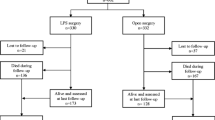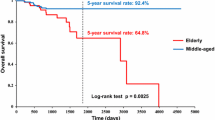Abstract
Background: Prospective randomized multicenter studies comparing laparoscopic with open colorectal surgery are not yet available. Reliable data from prospective multicenter studies involving consecutive patients are also lacking. On the basis of the personal caseloads of specialized surgeons or of retrospective analyses, it is difficult to judge the true effectiveness of this new technique. This study aims to investigate the results of laparoscopic colorectal surgery in consecutive patients operated on by unselected surgeons.
Methods: This observational study was begun August 1, 1995, in the German-speaking part of Europe (Germany and Austria) and 43 centers initially agreed to participate. All consecutive cases were documented. All data were rendered anonymous. Analysis was performed on an intention-to-treat basis. The study committee was blinded to the participating center.
Results: By the end of the 1st year, 500 patients (M:F ratio 0.83, mean age 62.9 years) had been treated by 18 centers; 269 operations were performed for benign indications and 231 for cancer (palliative and curative). Most operations were done on the distal colon or rectum. An anastomosis was performed in 84%, with an overall leakage rate of 5.3% (colon 3.6% and rectum 11.8%), which required surgical reintervention in 1.7%. The mean operating time was 176 min and showed a decreasing tendency over the period under study. The conversion rate was 7.0% and the overall complication rate 21.4%. The reoperation rate was 6.6%; the most common cause was bleeding. There was one ureteral lesion (0.2%), but urinary tract infections were fairly common (4.8%). A postoperative pneumonia was diagnosed in 1.6% of the cases. No thromboembolic complications were reported. The 30-day mortality rate was 1.4% and overall hospital mortality 1.8%.
Conclusions: Laparoscopic colorectal operations are still rare (about 1% of all colorectal operations in Germany). Laparoscopic procedures are more common on the left colon and rectum than on the right colon. The surgical complication rate is acceptable, comparable with rates reported by others for open surgery. Cardiopulmonary and thromboembolic complications were rarely seen. Mortality and surgical morbidity rates do not differ significantly among participating centers. A learning curve, reflected by a shortening of the operating time and a somewhat lower conversion rate, was observed over the observation period.
Similar content being viewed by others
Author information
Authors and Affiliations
Additional information
Received: 3 February 1997/Accepted: 22 April 1997
Rights and permissions
About this article
Cite this article
Köckerling, F., Schneider, C., Reymond, M. et al. Early results of a prospective multicenter study on 500 consecutive cases of laparoscopic colorectal surgery. Surg Endosc 12, 37–41 (1998). https://doi.org/10.1007/s004649900588
Published:
Issue Date:
DOI: https://doi.org/10.1007/s004649900588




